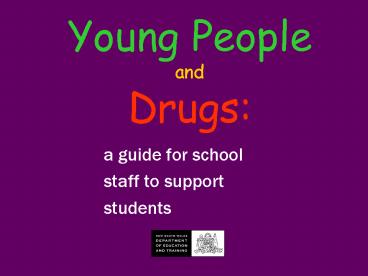Young People and Drugs: - PowerPoint PPT Presentation
1 / 24
Title:
Young People and Drugs:
Description:
... is taught within the PDHPE curriculum K 10 and Crossroads 11 ... Drug prevention: Home, school and community partnerships. Consult parents and local community ... – PowerPoint PPT presentation
Number of Views:1105
Avg rating:3.0/5.0
Title: Young People and Drugs:
1
Young People and Drugs
- a guide for school
- staff to support
- students
2
Purpose
To assist schools to
- implement appropriate prevention and intervention
strategies to support young people with drug use
problems - identify when a young person may have a drug use
problem - link young people and families to services and
resources - access drug and alcohol information services.
3
What is drug misuse?
- Drug misuse is any use of drugs that causes
physical, psychological, economic, legal or
social harm to the individual user or to others
by the drug users behaviour.
4
Problems associated with adolescent drug misuse
- Brain development in adolescence may be affected.
- Delayed maturation during adolescence may impede
important developmental tasks. - Drug use disorders are often associated with
mental health disorders, suicide and a history of
abuse.
5
Prevalence of drug use among young people 12 to
17 years
Table 3 Australian Secondary Students Alcohol
and Drugs (ASSAD) Survey 2005 Students aged 1217
years
6
IMPORTANT NOTE
- Most young people who try alcohol and illicit
drugs do not become problem drug users.
7
Reasons young people use drugs
- To experiment
- To have fun
- To heighten sensations
- To rebel
- To relax
- To relieve boredom
- To fit in with peers
- To cope with problems
- Because they are available
8
Indicators of possible drug use problems
- Changes in appearance and wellbeing
- Mood swings or significant personality change
- Loss of initiative
- Decline in academic performance
- Increased need for money and secrecy
- Intoxication at school
9
Identifying possible drug use problems
Cautionary notes
- Behavioural change may be due to causes other
than drug use. - Drug use is not necessarily drug misuse.
- Drug use may increase as a result of getting into
trouble for initial drug use and being labelled a
drug user.
10
Confidentiality
- Issues of confidentiality can arise when
teachers discuss possible drug use with students.
11
Limits of confidentiality
- Teachers have a duty of care to protect young
people against risks of harm. - Teachers should advise the principal of concerns
about the welfare and safety of young people. - Confidentiality may be limited by the
requirements to advise the principal of concerns. - Students should be advised of the limits to
confidentiality from the outset.
12
Talking to young people about possible drug use
- Consider who is the best person to approach the
student. - Express concerns that can be supported by facts.
- Encourage the student to talk.
- Listen carefully and avoid moralising.
- Dont use scare tactics.
- Offer information or help.
13
Strategies to support students
- Offer support and information
- Refer to the school counsellor for assessment and
support - Refer to outside agencies
- Provide school-based support as appropriate
- - Learning support team
- - Support teacher/learning
- - Support teacher/behaviour
- - Home school liaison officer.
14
Useful contacts for schools
- Drug education consultants
- Student welfare consultants
- Area School-Link coordinators
- NSW area health drug and alcohol services
- Telephone help lines
- Websites
- DET resources
15
What is the role of the school in prevention?
- Providing a safe and supportive school
environment where a students social, emotional
and learning needs are met is most important in
preventing drug use problems.
16
A framework for prevention of drug use problems
17
Drug prevention Safe, supportive and engaging
environment
- Promote a sense of belonging at school
- Provide support at transition points
- Build positive social behaviours and problem
solving skills - Promote pastoral care relationships
18
Drug prevention Quality learning and teaching
- Provide a curriculum that engages and meets the
needs of students - Ensure drug education is taught within the PDHPE
curriculum K10 and Crossroads 1112 - Teach drug education in a planned, sequential and
developmentally appropriate manner
19
Drug prevention Home, school and community
partnerships
- Consult parents and local community
- Develop positive partnerships with local area
health, police and other support services to - - link students and their families to supports
- - ensure continuity of care for young people
- - strengthen response to drug issues.
20
Referral to the school counsellor
- The student has been suspended
- Drug use is associated with high levels of risk
- The student appears to be drug dependent
- Drug use interferes with life at school and in
the community - Drug use is associated with other problems
behavioural, family or mental health
21
The Stages of Change model
22
Involving parents and caregivers
- Be reassuring and dont over-dramatise
- Help the parents explore options
- Involve the student in decisions
- Give information and or suggest referral
- Allow the parents to express their concerns
23
Supporting students whose parents use drugs
- Reframe perceptions of disloyalty
- Encourage discussion
- Advise young people to seek help from a trusted
relative or family member - Promote a positive outlook
- Report suspected abuse and neglect
24
Helping students to be non-smokers
- Ensure students are aware of rules and
consequences - Do not automatically suspend for possession of
tobacco - Include tobacco education in PDHPE
- Provide information about QUIT programs or form a
QUIT group - Provide incentives to quit
- Display anti-smoking stickers and posters
- Use Smoke screen a smoking prevention resource
(Stages 3 and 4) - Participate in The Critics' Choice































